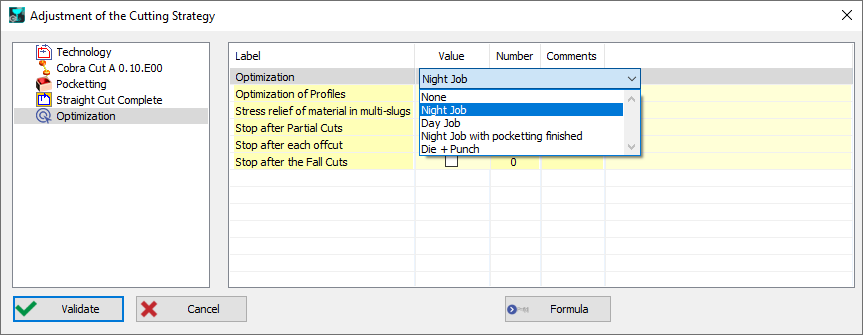Optimization
The optimization is the sequencing of operations to optimize the presence of the operator and the time of machining. It can be defined:
in the strategy itself,
it can be modified when applying the strategy,
it can be defined after the creation of toolpaths, in this case it combines die and punches shapes.
Four types of optimization are possible:
|  |
Night Job Optimization
Benefit: all roughing passes are carried out during the night. | Pocket cutting and partial dies are carried out in the operator’s absence. the smallest possible slug is left. A stop is applied after the operations. The slug cut for the dies operations is carried out in the operator's presence. A Stop is applied after for the operator to remove dies offcut. Finishing operations for the pockets and dies is carried out in the presence of the operator. A stop is applied after to prepare for the punch operations. Finally punch operations( partial cut, slug cut and finishing passes) are carried out it the operator’s presence. |
Night Job with pocketing finished Optimization
Benefit: time saving since there is no offcut(fall) in pocket operation. | The operation procedure is similar to Night Job optimization with only one difference. The finishing passes for pockets are also carried out in the night during the operator’s absence. |
Day Job Optimization
| Shape by Shape: the operator is present all the time and each part is finished one by one. |
Die and Punch Optimization This is a special case for a Part with both Die and Punch cutting operations
| Pockets, partial dies and partial punches operations are carried out in the absence of the operator. The benefit here is that maximum cuts are carried out before any manual action. A stop is applied after for the operator to clamp dies offcut and punches shapes at the same time. Slug cuts for the dies are carried out in the presence of the operator. A stop is applied after for the operator to remove the dies offcuts. Finishing passes for the dies and slug cuts for punches are then carried out in the absence of the operator. |
Optimization of Profiles The cut Optimization has priority but the order of the profiles selection may not be respected. Activating this option optimized the order of the profiles. | |
Stop after Partial cuts | Partial cuts: partial passes and cut of slug to micro slug |
Stop after each offcut | The aim is to be able to clamp the part, and cut and remove the offcut (fall) between each part |
Stop after the fall cuts | Stop between slug cutting and finishing (complete) passes |
